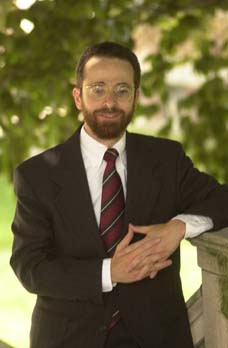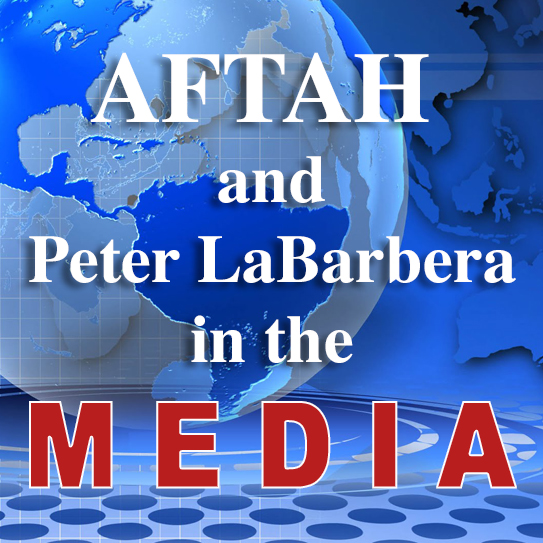
| Home | About | Issues | Resources | Join Our Email List | Savage Hate | Donate | Contact |
Prof. Gagnon’s Open Letter to U. of Toledo re: Suspension of Crystal Dixon
 NOTE: In AFTAH’s email version of this story, we erroneously cited the “firing” of Crystal Dixon. She has been suspended only and we apologize for the mistake.
NOTE: In AFTAH’s email version of this story, we erroneously cited the “firing” of Crystal Dixon. She has been suspended only and we apologize for the mistake.
The Open Letter below (emphasis added) is simply too informative not to pass on. Rob Gagnon is one of the world’s leading authorities on homosexuality and the Bible; Having heard him speak, I highly commend him as a visiting speaker at your church, synagogue or place of worship. The pro-homosexual theological revisionists — you know, the ones who make outlandish claims like that David and Jonathan in the Old Testament were “gay lovers” — are afraid to debate Rob. No wonder. You can learn more about Prof. Gagnon’s important work at www.robgagnon.net. — Peter LaBarbera
_____________________________
Pittsburgh Theological Seminary Professor Rob Gagnon’s open letter to the President of the University of Toledo, who suspended Ms. Crystal Dixon, Associate Vice President of Human Resources at the University, for rejecting an equation of homosexuality with ethnicity
(WND news story at www.worldnetdaily.com/index.php?pageId=63459; Lifesite story at www.lifesitenews.com/ldn/2008/may/08050605.html).
“I take great umbrage at the notion that those choosing the homosexual lifestyle are ‘civil rights victims.’ Here’s why. I cannot wake up tomorrow and not be a black woman.” — Crystal Dixon
TAKE ACTION: Read this letter, send it to all your friends and associates to educate them on the homosexual issue, and contact University of Toledo President Lloyd Jacobs (UTPresident@utoledo.edu) at: President Dr. Lloyd A. Jacobs, University Hall, Room 3500, Phone: 419.530.2211; Fax: 419.530.4984
From: Robert Gagnon (rgagnon@pts.edu)
Sent: Tue 5/6/2008 5:04 PM
Dear [U. of Toledo] President Jacobs,
I have read of your action in connection with Ms. Crystal Dixon, Associate Vice President of Human Resources at the University of Toledo (www.worldnetdaily.com/index.php?pageId=63459). Your suspension of Ms. Dixon for rejecting an equation of homosexuality with ethnicity constitutes, in my view, a gross injustice and an expression of the very intolerance that you claim to abhor. It is also predicated on a lack of knowledge and, as such, an abundance of prejudice.
Ms. Dixon is absolutely right that sexual orientation is not akin to race or sex. Unlike a homosexual orientation, race and sex are 100% congenitally predetermined, cannot be fundamentally changed in their essence by cultural influences, and are not a primary or direct desire for behavior that is incompatible with embodied structures.
Of course, generally people don’t wake up one morning and say, “I think I’ll be a homosexual.” Yet that is different from arguing that homosexual development is always and only something “given” like race and sex. Even the Kinsey Institute has acknowledged that nine out of ten persons who have experienced same-sex attractions have experienced at least one shift on the Kinsey spectrum from 0 to 6 during their life; six out of ten experienced two or more shifts. The intensity of impulses, and sometimes even their direction, can and often do change over time.
Edward Stein, a scholar of law and philosophy, has challenged deterministic models of homosexual development. He posits instead a nondeterministic model that incorporates a significant role for choice–often blind, incremental, and indirect but choice nonetheless (The Mismeasure of Desire: The Science, Theory, and Ethics of Sexual Orientation [New York: Oxford University Press, 1999]). Like various forms of sexual impulses, the degree to which a homosexual “orientation” becomes fixed in an individual’s brain and the intensity with which it is experienced, at least in part and for some, can be affected by choices regarding fantasy life, responses to social and environmental factors in childhood and adolescence, the degree to which one acts on impulses, and the degree of self-motivation for change. This is what the Harvard Gay and Lesbian Review had to say about Stein’s book: “A landmark book…. It so pulls the rug out from under biological arguments for lesbian and gay rights that anyone from now on who appeals to such arguments will have to answer to Edward Stein’s objections” (from back cover).
Without discounting congenital influences (which may create a higher risk factor for homosexual development, but nothing like a deterministic fait accompli), microcultural factors (familial and peer socialization) and macrocultural factors (societal incentives for or sanctions against homosexual practice) probably have a significant impact on the level of incidence of homosexuality in the population.
Consider the following:
1. Note the conclusion by the authors of the 1992 National Health and Social Life Survey-still the best representative survey of sexual practices in the United States. The latter write that a relatively uniform distribution of homosexuality in social groups “would fit with certain analogies to genetically or biologically based traits such as left-handedness or intelligence. However, that is exactly what we do not find. Homosexuality … is clearly distributed differentially within categories of … social and demographic variables” (Edward O. Laumann, John H. Gagnon, Robert T. Michael, and Stuart Michaels, The Social Organization of Sexuality: Sexual Practices in the United States [Chicago: University of Chicago, 1994], 307-10). “An environment that provides increased opportunities for and fewer negative sanctions against same-gender sexuality may both allow and even elicit expression of same-gender interest and sexual behavior.... There is evidence for the effect of the degree of urbanization of residence while growing up on reported homosexuality. This effect is quite marked and strong for men.” They also found that the relation of education to same-gender sexuality to “stand out for women in a way that it does not for men.” Women who were college graduates were significantly more likely to report same-sex partners, same sex desire, and homosexual/bisexual identity than were women who had only a high school degree or less. Laumann et al. attribute the difference in part to “greater social and sexual liberalism … and … greater sexual experimentation” that coincides with education. The fact that women are much less likely than men to be exclusively attracted to persons of the same sex and much more likely to vary sexual preference over time suggests that education is a cultural variable that can impact the incidence of homosexuality on some women.
2. A 1992 study of nearly 35,000 Minnesota junior and senior high school students concluded that “responses to individual sexual orientation items varied with age, religiosity, ethnicity, and socioeconomic status…. The findings suggest an unfolding of sexual identity during adolescence, influenced by sexual experience and demographic factors” (G. Remafedi, et al., “Demography of sexual orientation in adolescents,” Pediatrics 89:4 [Apr. 1992]: 714-21.
3. One of the best identical twin studies to date, done by J. Michael Bailey using the Australian Twin Register (rather than using biased sampling by advertising in homosexual publications, as he did in earlier studies), showed that only one out of ten times when one member of an identical twin pair self-identified as non-heterosexual (a Kinsey 3 to 6) did the co-twin likewise self-identify (J. Michael Bailey, et al., “Genetic and Environmental Influences on Sexual Orientation and Its Correlates in an Australian Twin Sample,” Journal of Personality and Social Psychology 78 [2000]: 524-36; quotes from pp. 533-4).
4 . The Columbia and Yale authors of one twin study using an enormous and nationally representative sample of adolescents (30,000) concluded: “Less gendered socialization in early childhood and preadolescence shapes subsequent same-sex romantic preferences” (Peter S. Bearman and Hannah Brückner, “Opposite-Sex Twins and Adolescent Same-Sex Attraction,” American Journal of Sociology 107.5 [2002]: 1179-1205). They found no significant difference in concordance rates for non-heterosexuality among identical twin pairs (6.7%) and fraternal twin pairs (7.2%), even though the latter are no more genetically ‘identical’ than non-twin siblings. Moreover, they found that opposite-sex twins were twice as likely to report same-sex attraction as same-sex twins; and that males without older brothers among opposite-sex twins were twice as likely to report same-sex attraction (18.7%) than their male counterparts with older brothers (8.8%).
5. According to William H. James, “There is an abundance of data suggesting that male homosexuals and paedophiles report having experienced more sexual abuse (however defined) in childhood (CSA) than do heterosexual controls…. There are grounds for supposing that some of the reports are veridical [causally related], and there is support from a longitudinal study reporting a small but significant increase in paedophilia in adulthood following CSA. To summarize: most boys who experience CSA do not later develop into homosexuals or paedophiles. However, the available evidence suggests that a few do so as a result of the abuse” (“Two Hypotheses on the Causes of Male Homosexuality and Paedophilia,” Journal of Biosocial Sciences 36 [2004]: 371-374; the quotation is from the abstract).
6. Another study indicates influences from family structure: Morten Frisch and Anders Hviid, “Childhood Family Correlates of Heterosexual and Homosexual Marriages: A National Cohort Study of Two Million Danes,” Archives of Sexual Behavior 35.5 (2006): 533-47. Firsch and Hviid concluded that men were more likely to marry homosexually if their parents had divorced or cohabited for only a short duration, if parental cohabitation had been characterized by long periods of a father’s absence, or if paternal identity were unknown. Women were more likely to marry homosexually if their parents had a short marriage or if the mother had been absent during the child’s adolescence because of abandonment of death. For each extra year that one’s parents stayed married, the percentage of those who married heterosexually went up 1.6% among sons and 1% among daughters, while the percentage of those who married homosexually went down 1.8% among sons and 1.4% among daughters. The study also found that having older brothers increased the likelihood of marrying homosexually, a result that stands in tension with a Canadian study that found that the incidence of homosexuality increases with in proportion to the number of older brothers.
The above studies should suffice for demonstrating the error of comparing an impulse-related condition like homosexuality with race and sex, so far as origination is concerned. Nor can they be compared as behavioral conditions. The former is a primary desire for form of behavior that is structurally discordant; the latter are not. This leads to the next issue.
Why is homosexual practice wrong? One can point to the disproportionately high rate of measurable harm that attends male homosexual relationships and female homosexual relationships. The former exhibit markedly higher numbers of sex partners over the course of life and markedly higher incidence of sexually transmitted infections, even relative to homosexual females. The latter exhibit a markedly higher incidence of mental health issues and markedly shorter durations of sexual unions on average, even relative to homosexual males.
Many would like to attribute these higher rates of measurable harm primarily to societal “homophobia.” Yet such a supposition (for that is all that it is) is contradicted by two facts. First, these problems persist, at similar rates, even in the most homosex-affirming cultures, both within the United States, and in Canada and the most “liberal” parts of Western Europe. Second, societal “homophobia” doesn’t explain why the types of harm affect homosexual males and homosexual females at different rates and in ways that reflect male-female differences.
For example, significantly higher rates both of sexual partners over the course of life and of STIs is exactly what we would expect of all-male sexual bonds since, as cross-cultural (and even cross-species) studies have shown, males find monogamy more difficult than females. Put two men together in a sexual bond without the benefit of female socialization and the results are predictable. Similarly, the fact that homosexual females exhibit higher rates of mental health complications is a reflection of the reality that females generally experience higher rates than do males as regards quality-of-relationship issues (i.e., women invest more of their self-worth in such relationships, which creates a problem when the relationships fail), now ratcheted up in all-female unions. And female homosexuals experience shorter-term relationships on average, even in comparison to male homosexual bonds, because females generally put greater demands on the quality of the relationship in order to satisfy their own individual needs, which in turn puts higher stress on the relationship. Put two women together, each making the same high demands, and one will predictably get a relatively short union. There are, of course, exceptions to the rule but the exceptions don’t invalidate the rule.
Putting two (or more) people of the same sex in a sexual union does nothing for moderating the extremes of a given sex or filling in the gaps of a given sex. It rather exacerbates the extremes and highlights the gaps. That is the nature of a one-sex sexual bond. This measurable reality discloses the non-measurable problem of attempting sexual merger with someone who is not a true sexual complement. The disproportionately high rates of problems cited above, as bad as they are, are only symptoms of the root problem.
What is the root problem? The root problem is erotic attraction for, and the attempt to merge sexually with, what one already is as a sexual being. Those who claim exclusive orientation toward members of the same sex tacitly know that what they desire from a person of the same sex is something that they believe is unobtainable from a person of the other sex; namely, more of the essential quality of their own sex. A male wants more maleness, which he believes that he cannot obtain from a sexual bond with a female. Conversely, a female wants more femaleness, which she believes that she cannot acquire from a sexual relationship with a male, even a gender-nonconforming male.
It is axiomatic and undeniable that a male or a female is only one half of a complete sexual whole since, obviously, there are two primary sexes. The sexual complement to a man is not another man but a woman; and to a woman is not another woman but a man. The logic of a male-female sexual bond is that the two primary sexual halves are united into a single complementary sexual whole. The logic of a same-sex sexual bond is that each partner is only half his or her own sex, which unites to form a whole male or a whole female. Such a union dishonors the integrity and completeness of one’s maleness, if male, or femaleness, if female.
A homosexual person, despite what he or she may think, is not half of his or her own sex but half of the full male-female sexual spectrum. A person may be in need of “structural affirmation” from members of the same sex, but not “structural supplementation.” Merging sexually with another of the same sex does not make one “more” male, if male, or “more” female, if female. Rather, it has the opposite effect: regularizing the self-misperception that one can complete one’s own sex only by uniting sexually with someone of the same sex.
The closest parallels to adult-committed homosexual relations is not ethnicity or gender but rather adult-committed incestuous unions and adult-committed polysexual unions (i.e., sexual unions involving more than two persons concurrently). The root problem with adult-committed incest must be applicable even when the relationship will not produce children (e.g., when one partner is infertile or takes birth-control precautions; or when the union is a case of homosexual incest). That root problem is that two people who are too much alike on level of kinship and who are thus already members of the same “flesh” attempt to become “one flesh.” It is an instance of too much structural sameness, not enough complementary otherness. This is the same problem with homosexual bonds, only now the sameness is more keenly felt on the level of sex or gender. So adult-committed incest and adult-committed homosexual unions are analogically related.
As regards polyamorous unions of a committed sort (i.e. unions with three or more sex partners), the connection with homosexual practice is not analogical but foundational. That is to say, the restriction of validated sexual unions to two persons at any one time is ultimately predicated on the sexual dimorphism, or “twoness,” of the sexes. It is because a sexual union between a man and a woman so brings together the full range of human sexuality that a third party is neither necessary nor desirable. Once the importance of the twoness of the sexes is disregarded, there no longer remains a logical or nature-based reason for limiting the number of partners in a sexual bond to two, especially since many people experience an innate and intense polysexual orientation that is not of their choosing.
Nor can the counterargument be made that a person can only really love one other person concurrently. For parents don’t love their first child any less when a second child comes. Moreover, most people have many intimate (but non-sexual) friends, not just one. Yes, there is something special about sexual bonds that requires a limitation to two persons. But that “something special” is the fact that a man is the true sexual complement to a woman and woman to a man, on a holistic level: anatomically, physiologically, and psychologically. To disregard that obvious reality is to leave oneself without rational grounds for dismissing consensual and committed sexual unions involving more than two persons.
So, given your full affirmation of homosexual activity, you are left with Oprah Winfrey’s conclusion after meeting some economically upscale, adult-committed polygamists for a 2007 show: “The best part of doing this job … [is that] I come in with one idea and then I leave a little more open about the whole idea. And what I realize … is that in every situation there are people who give things a bad name. There are difficulties and then there are people who handle those difficulties differently” (“Polygamy in America: Lisa Ling Reports,” www.oprah.com/tows/pastshows/200710/tows_past_20071026.jhtml?promocode=ssend20071026TD; full video at http://video.aol.com/video-search/query/oprah%20winfrey%20&%20lisa%20ling).
Give America more exposure to upscale, adult-committed polygamous bonds (and adult-committed incestuous bonds) and America will learn to be more tolerant of such bonds, as Oprah has. Those who dismiss a polygamy analogy and an incest analogy on the grounds that polygamy and incest always produce “demonstrable harm” are simply responding out of their “polyphobia” and “incest-phobia.” And then you can suspend people who say critical things about such relationships, once you overcome your prejudices.
I hope as a president of a university you will provide your students with an example of thoughtful and rigorous reflection rather than the kind of harsh, knee-jerk response that you have thus far taken. Instead of suspending Ms. Dixon you should be singing her praises for her honesty and her courage of conviction.
Sincerely,
Robert A. J. Gagnon, Ph.D.
Associate Professor of New Testament
Pittsburgh Theological Seminary
____________________________
Current and Favorite Articles on www.AmericansForTruth.org
Brett VanAsdlen’s Mom: “We’re Just Getting Persecuted Here”
Illinois Teen Faces Three Years Jail Sentence for Potentially Fraudulent ‘Hate Crime
The Untold Story about Rep. Sally Kern
The Face of Intolerance: Lesbian Riot Shuts Down Sorba Speech at Smith College (have you watched the video yet?)
Hutcherson Update: 638 Students Boycotted DOS at Mt. Si High
Homosexual Activist Wayne Besen Makes a Strong Case for a Federal Marriage Amendment
LaBarbera Calls for ‘Breaking the Silence’ on the Health Risks of Homosexual Behavior
___________________________
Americans For Truth Needs You!
The homosexual activist lobby is more arrogant than ever — and quite willing to shut down opponents’ speech (in the name of tolerance, of course). That’s why we need Americans For Truth. To make a tax-deductible donation to AFTAH, click on our online donation page (you can use your own credit card or PayPal) at: www.americansfortruth.com/donate.
We are grateful for those of you who have signed up as monthly “Truth Team” givers by pledging a donation on of at least $20/month to AFTAH. We think this is a good investment in your children’s and their children’s future! Our goal is to sign up 1,000 monthly AFTAH ‘Truth Team’ givers to put us on healthy financial footing. You can also send your tax-deductible donation via regular mail to:
Americans For Truth, P.O. Box 5522, Naperville, IL 60567-5522










